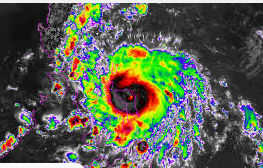Tens of thousands of people crammed into evacuation centers while trying to follow social distance protocols for the new coronavirus disease (COVID-19) on Friday, as a powerful typhoon hammered the Philippines.
Typhoon “Ambo” (international name: Vongfong) has dumped heavy rains and torn off roofs since it roared ashore on Samar Island on Thursday, with hundreds of thousands of vulnerable people in its path on the coast or in flimsy homes.
The storm hit as tens of millions of Filipinos were hunkered down at home against the coronavirus, but at least 141,700 had to flee because of the powerful storm, according to disaster officials.
Gov. Ben Evardone of Eastern Samar, where Ambo made landfall with 155-kilometer per hour winds and gusts of up to 185 kph on Thursday, described the typhoon as “Yolanda Jr.”
Supertyphoon “Yolanda” (international name: Haiyan) was the strongest typhoon to ever hit land. It left more than 7,000 people dead and caused P130 billion in damages in November 2013.
“[The] devastation in my province is so enormous and unimaginable that I can safely say that Ambo was Typhoon Yolanda Jr. in terms of damage to infrastructure,” Evardone said in a text message.
“This is a double whammy for us because we are also facing this COVID-19 crisis,” he said.
Aside from houses, Evardone said public structures were also damaged by the typhoon, including evacuation centers and classrooms which had been turned into COVID-19 isolation centers.
High winds blew the roof off a church in Arteche town, officials said.
Evardone said newly harvested rice, coconut, corn and root crops were also damaged. He gave no immediate estimate of the amounts lost.
Houses and gymnasiums in the municipalities of Maslog and Oras, both in Eastern Samar, were also destroyed. Several areas were also rendered impassable due to floods.

Photo credits INQ.net
Power was restored on Friday in some parts of Eastern Samar, including its capital city of Borongan, although supply was not stable.
The Bicol region was not directly hit by the typhoon but thousands were evacuated from the slopes of Mayon Volcano ahead of the typhoon’s arrival.
By Friday morning, however, Albay Gov. Al Francis Bichara ordered the decampment of close to 16,000 displaced families that had stayed at various evacuation shelters, churches, and in houses of relatives.
In Sorsogon, Dong Mendoza, spokesperson for Sorsogon Gov. Francis “Chiz” Escudero, in a text message said 19,000 families, or 70,000 people, who had evacuated were allowed to return home.
The rains also flooded several towns in the region.
In Oas town, Sorsogon, houses in Iraya Norte village were submerged in floodwaters.
“I’m really traumatized. We have not yet fully recovered after Typhoon [‘Tisoy’ in December 2019] struck us, now here’s Ambo. All my belongings are gone except for my pet dogs and motorcycle,” said villager Ruth Razal.
In Libon, 10 villages were flooded, Mayor Das Maronilla said.
In Guinobatan town, heavy rocks and sand cascaded down to the foot of Mayon Volcano, blocking the road in Maninila village, Mayor Ann Ongjoco said.
In Bulan town, Sorsogon, several hectares of rice, corn and vegetables were ravaged by Ambo.
But in Quezon, Typhoon Ambo’s howling winds and heavy rainfall over Bondoc Peninsula were not as strong as Tisoy (international name: Kammuri) that pummeled the province last December.
Melchor Avenilla Jr., head of Quezon disaster risk reduction and management office, citing reports from San Andres town, said, “Ambo’s wrath was only half the strength of Tisoy.”

Photo credits INQ.net
The typhoon was downgraded to a severe tropical storm on Friday with sustained winds of 100 kph and gusts of up to 165 kph. It was over the vicinity of Trinidad, Bulacan, at 8 p.m. on Friday.
Heading to Ilocos
It was heading toward the Ilocos Region at 20 kph and expected to be 85 kilometers northwest of Laoag, Ilocos Norte, by Saturday afternoon.
It was tracked to hit the Babuyan Group of Islands or Batanes on Sunday, according to the Philippine Atmospheric, Geophysical and Astronomical Services Administration.
“The entire Luzon will have to prepare for heavy rains until Saturday,” said weather specialist Ariel Roxas.
Metro Manila should expect moderate to heavy rains, which could be intense at certain times, until Saturday.
Signal No. 2 is still raised over the following areas: Ilocos Norte, Ilocos Sur, Apayao, Abra, Kalinga, Mountain Province, Ifugao, Benguet, La Union, Nueva Vizcaya, Nueva Ecija, Quirino, Aurora, the eastern portion of Pangasinan, Tarlac, Pampanga, Bulacan, Metro Manila, Cavite, Laguna, Rizal, the northern and central portion of Quezon, Polillo Islands, and the southern and western portions of Isabela.
Damaging gale
These places will experience “strong to damaging gale during the passage of the typhoon.”
Cagayan, including Babuyan Islands, Batanes, Zambales, Bataan, the rest of Isabela, Batangas, Marinduque, the rest of Quezon, Camarines Norte, and the northwestern portion of Camarines Sur are under Signal No. 1.
Presidential spokesperson Harry Roque on Friday reassured the public of the government’s preparedness for Ambo, saying Malacañang was closely monitoring the situation in areas hit by the typhoon.
“We ask the public, especially those who will be hit by Ambo, to remain vigilant and to cooperate with authorities as they implement their disaster preparedness and response to ensure everyone’s safety,” he said.
The first typhoon to hit the country this year came as it grappled with the COVID-19 pandemic.
The measures being taken against the new coronavirus added to the misery experienced by people in its path.
“We have to wear masks and apply distancing at all times,” local police official Carlito Abriz told French news agency Agence France-Presse (AFP). “It’s difficult to enforce because they (the evacuees) are stressed. But we are doing our best.”
Challenge in social distancing
Authorities have said they would run shelters at half of capacity, provide masks to people who didn’t have them and try to keep families grouped together.
However, many spaces normally used as storm shelters have been converted into quarantines for people suspected of being infected with coronavirus.
“The challenge really lies in the physical distancing,” said disaster official Junie Castillo, who added they were housing people in classrooms emptied by the pandemic.
Fortunately the Visayas region where the storm struck first is not one of the hot spots of the COVID-19 outbreak.
No typhoon deaths were immediately reported, but disaster crews were just beginning on Friday their assessment of hard-hit areas cut off by the storm.
Many of the areas in Ambo’s path have already gone through much of their emergency disaster money while responding to the pandemic, and have asked the national government for help.
What can you say about this? Share it in the discussion box below.





